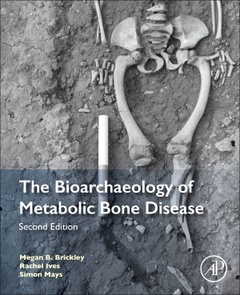Description
The Bioarchaeology of Metabolic Bone Disease (2nd Ed.)
Authors: Brickley Megan B., Ives Rachel, Mays Simon
Language: English
Subjects for The Bioarchaeology of Metabolic Bone Disease:
Keywords
?Anaemia; Anthropology; Ascorbic acid; Bio-cultural; Bioarchaeology; Biological approach; Bone; Bone cells; Bone growth; Bone lesions; Bone loss; Bone maintenance; Bone marrow; Cardiovascular disease; Co-morbidity; Co-occurrence; Colles’ fracture; Cribra orbitalia; Dentin; Diabetes; Diagnosis; Fluorosis; Fragility fracture; Haemorrhage; Hip fracture; Infectious disease; Interglobular dentine; Iron deficiency anaemia; Mechanical loading; Metabolic disease; Metabolic syndrome; Microscopy; Multi-morbidity; Osteitis deformans; Osteobiography; Osteoimmunology; Osteomalacia; Osteoporosis; Osteosarcoma; Paget’s disease of bone; Palaeopathology; Paleopathology; Pellagra; Porotic hyperostosis; Porous bone lesions; Post-menopausal; Radiography; Residual rickets; Rickets; Scurvy; Sub-periosteal new bone formation; Vertebral compression fracture
78.38 €
In Print (Delivery period: 14 days).
Add to cart328 p. · 19x23.3 cm · Paperback
Description
/li>Contents
/li>Readership
/li>Biography
/li>Comment
/li>
The Bioarchaeology of Metabolic Bone Disease, Second Edition is a comprehensive source dedicated to better understanding this group of conditions that have significant consequences for health in both past and present communities on a global scale.
This edition presents an updated introduction to the biology and metabolism of mineralised tissues that are fundamental to understanding the expression of the metabolic bone diseases in skeletal remains. The extensive advances in understanding of these conditions in both bioarchaeological and biomedical work are brought together for the reader. Dedicated chapters focussing on each disease emphasise the integration of up-to-date clinical background with the biological basis of disease progression to give guidance on identification. New chapters covering anaemia and approaches to recognising the co-occurrence of pathological conditions have been included, reflecting recent advances in research. Boxes highlighting significant issues, use of information from sources such as texts and nonhuman primates, and theoretical approaches are included in the text. Each chapter closes with ?Core Concepts? that summarise key information. The final chapter reviews current challenges in bioarchaeology and provides directions for future research.
This is a must-have resource for users at all career stages interested in integrating information on the metabolic bone diseases into bioarchaeological projects.
1. Introduction to the study of Metabolic Bone Disease2. The Study of Metabolic Disease in Bioarchaeology3. Biology and Metabolism of Mineralised Tissues4. Vitamin C Deficiency, Scurvy5. Vitamin D Deficiency6. Age-related bone loss and Osteoporosis7. Secondary Osteoporosis8. Paget’s Disease of Bone9. Anaemia10. Disease Co-occurence11. Overview and Future Directions for Research
Primary: Researchers in Anthropology, bioarchaeology and archaeology
Secondary: Graduate students, undergraduate students studying in anthropology, bioarchaeology, and archaeology
Dr Rachel Ives is the Curator of Anthropology in the department of Earth Sciences at the Natural History Museum, London. She is responsible for the curation of the palaeoanthropology, fossil primate, human remains, and artefact collections and promotes scientific research, exhibitions, and outreach access to the collections. Rachel’s research interests are in bone cell biology together with skeletal palaeopathology, particularly the metabolic bone diseases and disease co-occurrence. Rachel has carried out large-scale surveys of metabolic bone diseases in urban contexts and was a post-doctoral researcher on a Calleva Foundation funded Child Health project at the NHM, investigating how the skeleton changes during childhood growth and in response to pathology. Rachel previously worked in the commercial sector carrying out archaeological cemetery excavations and osteological analyses, and she continues work in osteoarchaeological consultancy for heritage development projects.
Simon completed his PhD in archaeology in 1987, and then spent a year teaching archaeology to schoolchildren. He then took up a job as Human Skeletal Biologist for Historic England, a post he still holds. This involves promulgating advice and standards for treatme
- Covers deficiencies of vitamin C and D, osteoporosis (age-related and secondary), Paget’s disease of bone, anaemia and approaches to disease co-occurrence
- Contains clear and user-friendly guidance for macroscopic, radiological and microscopic diagnoses
- Highlights current inquiries and debates in biological anthropology, bioarchaeology, palaeopathology, medical history and clinical/biomedical research
- Extensive figures, most new or updated, provide invaluable information on biological processes and lesion expression through diagrams and photographs

